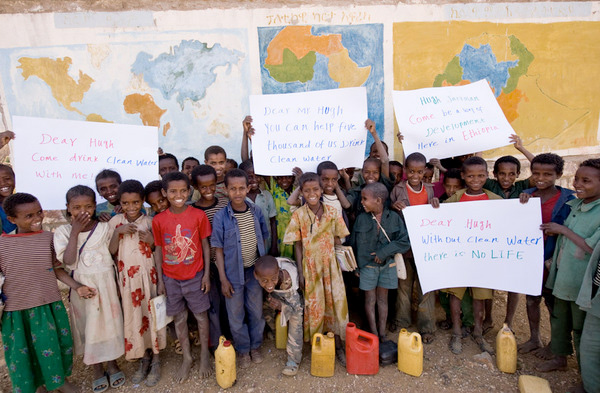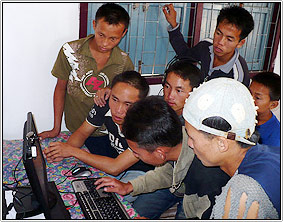Jhai Harmony – Your Support Needed
“There are tens of thousands of dead computers in rural villages all over the world,” says Jhai Foundation Chair Lee Thorn.
“The real problem of sustainability is how do people make money off this technology so they stay interested in it for a long time. Otherwise it’s just some white guy’s dream.”
Jhai Foundation uses community organizing techniques to understand the potential ICT needs in a given village. They go beyond needs assessments to needs dialogues. They then train the entrepreneurs in business and the technology. A local entrepreneur comes up with a business plan that will employ villagers, maintain the computers, and pay for Internet access and electricity. Jhai is experimenting with partners who are setting up sustainable businesses in clinics, community centers and schools.
How did Jhai come to this approach?
As a naval serviceman in the Vietnam War, Lee Thorn helped load planes with bombs meant for airstrikes on Laos. Thirty years later, after working as an activist, business consultant, and teacher, Lee traveled to Southeast Asia in search of reconciliation, and found it through lasting friendships and projects to reinvigorate rural villages.
Since 1997, his Jhai Foundation has helped Laotians and others secure medical supplies, build schools, and establish coffee farms and other businesses.
Jhai listens carefully to the local villagers, and helps them identify needs and opportunities, and create business plans. Local solutions then meet the unique needs of each community, providing sustainable incomes.
Jhai is up and running in Laos and India, and is in discussions in Viet Nam, Ghana, Rwanda, and Bangladesh. The Foundation needs your support at this juncture, to bridge the gap between seven years of R & D, and widespread deployment. Click the hands logo at Jhai.org and donate NOW! (A new website is in the works.)
What’s next for Jhai?
Jhai Foundation has had a 90% success rate over the last 12 years helping local entrepreneurs set up 70 local businesses.
The new JhaiPC 2.0 has been tested in schools and, now, clinics. Jhai with partners will deploy next in sustainable telemedicine implementations. Sustainable telemedicine allows good record-keeping and sharing, measures of five vitals, including EKG, and 2 A/V windows – all at low bandwidth, low cost and low power. Jhai has had inquiries from 60 countries for their tools.
As Chairman of the Jhai Foundation Board, Lee is now focusing on the expansion of operations. He is also working to develop the sustainability of the Jhai Foundation.
To learn more, please visit Jhai.org or contact Lee at lee@jhai.org.
Thanks to Gisela Angela Telis, and her article in the Christian Science Monitor for Lee’s quote.
Why, in addition to greed, it hasn’t worked out the way Bucky hoped…
In pursuit of deeper “sustainability” understanding, I recently read “The Spell of the Sensuous” by David Abram (highly recommended), and started “Natural Capitalism.” Early on in NC was a mention of Buckminster Fuller’s concept of “ephemeralization,” the tendency of new technology to achieve ever more, using less and less resources.
In 1939, Bucky pointed out that there really are enough resources for all of humanity to live successfully on this planet, and that we could design our way to reasonable prosperity for all.
Indeed technology has produced more and more using less and less resources, and we have made some progress toward providing a decent standard of living for more humans, but we are clearly still far from the goal. And most of us continue to believe there is not enough for everyone, thus somehow justifying our drive to get more and more for ourselves.
In addition to a short discussion of ephemeralizaiton in Wikipedia, was this:
Consequences [of ephemeralization] to society
Heyligen[2] , Alvin Toffler, and others have written about how ephemeralization, though it may increase our power to solve physical problems, can make non-physical problems much worse. Increasing system complexity and information overload make it difficult and stressful for the people who must control the ephemeralized systems. This can negate the advantages of ephemeralization.
Heyligen speaks about the development of the “Global Brain” and the “economy of attention” needed to cope effectively with the incredible explosion of information and connections resulting from ephemeralization.
Following are several relevant excerpts from the paper:
“Goldhaber (1997) suggests that the traditional economy, based on the exchange of material wealth, is being replaced by an economy based on the exchange of attention.
“This view of the attention economy has a basic flaw, though: attention is not a tradeable good. While attention is valuable both when spending it and when receiving it, the one cannot compensate for the other. All the attention that is focused on a famous person’s private and public life will not help that person tackling information overload…..
“One reason why attention is so difficult to allocate rationally is that people have very little control over the emotional drives, such as sex, status, and danger, that focus their attention on one subject rather than another.
“Yet, several authors (e.g. Stewart, 2000; Czikszentmihalyi, 1990), building on centuries-old spiritual traditions such as yoga, meditation and Zen Buddhism, have argued that it is both possible and desirable for people to learn to control these drives.”
“The present drive therefore is not so much for independently intelligent programs, but for systems that support or “augment” human intelligence (IA, that is, Intelligence Amplification, rather than AI).”
“The solution proposed in this paper is the integration of the three basic resources: human intelligence, computer intelligence, and coordination mechanisms that direct an issue to the cognitive resource (document, person, or computer program) most fit to address it. This requires a distributed, self-organizing system, formed by all individuals, computers and the communication links that connect them. The self-organization can be achieved by algorithms similar to those underlying the learning of associations in the brain, the laying of trails by ants, or the invisible hand of the market. The effect is to superpose the contributions of many different human and computer agents into a collective “mental map” that links all cognitive and physical resources in the most efficient way possible.”
“The resulting information system would be available always and everywhere, reacting immediately to any request for guidance or any change in the situation. It would constantly be fed with new information, from its myriad human users and computer agents, which it would take into account to find the best possible ways to achieve any task it is confronted with. Optimization would take place both at the level of the individual who makes the request, and at the level of society which tries to minimize the conflicts between the desires of its different members and to aim at long term, global progress while as much as possible protecting individual freedom and privacy. Such an intelligent, adaptive, “omniscient” system can perhaps be best understood through the metaphor of the global brain.”
This is the beauty of carefully crafted social networks. The global brain is growing!
NEXT
Information Anxiety ?? – Not Me!
Where’s the Tofu
The best communication strategy is a good reputation.
References
1. ^ R Buckminster Fuller, Nine Chains to the Moon, Anchor Books 1938, 1971 pp 252- 259
2. ^ Heyligen, Complexity and Information Overload in Society: why increasing efficiency leads to decreasing control http://web.archive.org/web/20070103091059/http://pespmc1.vub.ac.be/papers/Info-overload.pdf
Draft paper, version: April 12, 2002, to be submitted to: The Information Society Complexity and Information Overload in Society: why increasing efficiency leads to decreasing control –
Francis HEYLIGHEN
CLEA, Free University of Brussels, Pleinlaan 2, B-1050 Brussels, Belgium
http://pcp.vub.ac.be/HEYL.html



